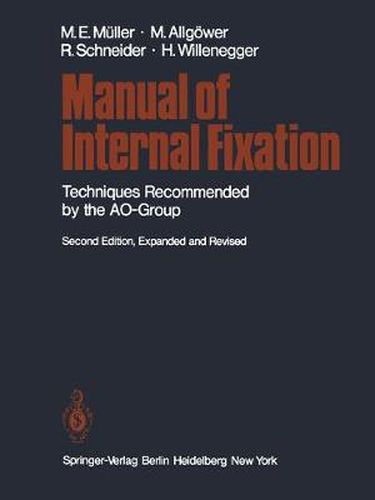Readings Newsletter
Become a Readings Member to make your shopping experience even easier.
Sign in or sign up for free!
You’re not far away from qualifying for FREE standard shipping within Australia
You’ve qualified for FREE standard shipping within Australia
The cart is loading…






This title is printed to order. This book may have been self-published. If so, we cannot guarantee the quality of the content. In the main most books will have gone through the editing process however some may not. We therefore suggest that you be aware of this before ordering this book. If in doubt check either the author or publisher’s details as we are unable to accept any returns unless they are faulty. Please contact us if you have any questions.
The first part of this manual deals with the experimental and scientific basis and the principles of the AOjASIF method of stable internal fixation. It deals with the function and main use of the different AO implants, the use of the different AO instruments, and with the essentials of the operative technique and of postoperative care. It also discusses the handling of the most important postoperative complications. The second part deals at length with the AO recommendations for the operative treatment of the most common closed fractures in the adult. This has been organized in anatomical sequence. The discussion of the closed fractures is followed by a discus sion of open fractures in the adult, then by fractures in children and finally by pathological fractures. The third part presents, in a condensed fashion, the application of stable internal fixation to reconstructive bone surgery. 1 GENERAL CONSIDERATIONS 1 Aims and Fundamental Principles of the AO Method The Chief Aim of Fracture Treatment is the Full Recovery of the Injured Limb In every fracture there is a combination of damage to both the soft tissues and to bone. Immediately after the fracture and during the phase of repair, we see certain local circulatory disturbances, certain manifestations of local inflammation, as well as pain and reflex splinting. These three factors, that is, circulatory disturbances, inflammation and pain, when combined with the defunctioning of bone, joints and muscle, result in the so-called jl'acture disease.
$9.00 standard shipping within Australia
FREE standard shipping within Australia for orders over $100.00
Express & International shipping calculated at checkout
This title is printed to order. This book may have been self-published. If so, we cannot guarantee the quality of the content. In the main most books will have gone through the editing process however some may not. We therefore suggest that you be aware of this before ordering this book. If in doubt check either the author or publisher’s details as we are unable to accept any returns unless they are faulty. Please contact us if you have any questions.
The first part of this manual deals with the experimental and scientific basis and the principles of the AOjASIF method of stable internal fixation. It deals with the function and main use of the different AO implants, the use of the different AO instruments, and with the essentials of the operative technique and of postoperative care. It also discusses the handling of the most important postoperative complications. The second part deals at length with the AO recommendations for the operative treatment of the most common closed fractures in the adult. This has been organized in anatomical sequence. The discussion of the closed fractures is followed by a discus sion of open fractures in the adult, then by fractures in children and finally by pathological fractures. The third part presents, in a condensed fashion, the application of stable internal fixation to reconstructive bone surgery. 1 GENERAL CONSIDERATIONS 1 Aims and Fundamental Principles of the AO Method The Chief Aim of Fracture Treatment is the Full Recovery of the Injured Limb In every fracture there is a combination of damage to both the soft tissues and to bone. Immediately after the fracture and during the phase of repair, we see certain local circulatory disturbances, certain manifestations of local inflammation, as well as pain and reflex splinting. These three factors, that is, circulatory disturbances, inflammation and pain, when combined with the defunctioning of bone, joints and muscle, result in the so-called jl'acture disease.